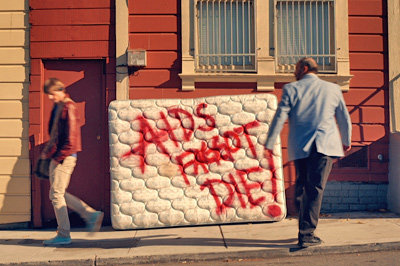This month, there are several films — two in theaters and two on TV — that celebrate gay men and examine issues of sexual identity. All are worth watching.
Opening June 6 at Ritz Theaters is the terrific documentary “Gore Vidal: The United States of Amnesia.” This candid profile of the queer writer features interviews and clips from TV (“The Johnny Carson Show”), as well as priceless quips and anecdotes about Vidal’s books (“The City and the Pillar”), films (“Myra Breckenridge”), plays (“The Best Man”) and screenplays (“Ben-Hur”), famous friends (The Kennedys) and details of his personal life with his partner Howard Austen. This documentary is a fantastic primer for viewers unfamiliar with Vidal’s life and work, but it is also satisfying for those who know the icon. But what makes “Gore Vidal: The United States of Amnesia” special is seeing Vidal in his element — be it clearing out his home in Ravello, Italy, fighting with William F. Buckley on TV or walking through the cemetery where both Austen and Jimmy Trimble, the young man he loved and lost, are buried. This is an elegiac portrait of one of the most vibrant and dynamic queer figures from political and literary history.
Screening one night only — June 11 at the Balcony at the Trocadero — is “Test,” a compelling, low-budget drama set in 1985 San Francisco about the onset of the AIDS crisis. Frankie (Scott Marlowe) is a dancer whose unease about the disease is palpable. His concerns are contrasted with those of his fellow dancer, Todd (the magnetic Matthew Risch), who has a more reckless attitude towards life and sex. In Frankie’s eyes, Todd seems more likely to get “it” because of his behavior, but Frankie goes to get tested after a series of sexual encounters scares him.
“Test” conveys the anxiety of the early days of AIDS, and the way young gay men grappled with their fears. It is to the film’s credit that viewers care about what happens to his character.
But “Test” is about trials other than just one’s HIV status. Frankie is tested as an understudy in a dance company when he gets the opportunity to perform at one point in the film. The lengthy dance sequences — both rehearsals and performances — are enjoyable to watch.
Another “test” in the provocative “Test” is a point raised in the film’s end, where a character suggests AIDS enforces monogamy for gay couples — that it is “like a test.”
On VOD June 6 is “Burning Blue,” an intense, engrossing drama about a military investigation that turns up a possible “gay cell” on a Navy Aircraft carrier. Daniel (Trent Ford) and William (Morgan Spector) are best buddies. When Matthew (Rob Mayes) enters their unit, a love triangle tinged with jealousy develops. (One of the men is straight.)
Writer/director DMW (David) Greer, adapting his own play, has crafted a poignant story about masculinity and sexuality within the culture of the military. “Burning Blue” is really about wanting what others say you can’t have. Ford’s strong performance is freighted with Daniel’s guilt over various issues. The film, which ends in 2001, is also an emboldening cautionary tale about “Don’t Ask, Don’t Tell.”
On HBO June 9 is the short documentary “Remembering the Artist: Robert De Niro, Sr.” Most fans of Robert DeNiro may not know that his father was an accomplished, if under-appreciated, artist. DeNiro Sr. exhibited in Peggy Guggenheim’s Art of This Century Gallery and was a contemporary of abstract expressionists like Pollock, de Kooning and Rothko. Yet DeNiro Sr. was different; he was a figurative painter influenced by French masters and therefore marginalized in the 1950s New York art scene. He did not fit in with the other artists of his era, and certainly not with the pop artists like Warhol, who came to prominence in the 1960s.
As this wistful but affectionate short film shows, DeNiro Sr. was also a gay man, who struggled with conflicted feelings about his sexuality, as well as with depression and frustration at not being more recognized for his work. “Remembering the Artist” features poignant photographs, film clips, diary excerpts and interviews with DeNiro Jr. as well as artists and critics, to illuminate the life and career of the late DeNiro Sr. and give him the respect and recognition he craved.

